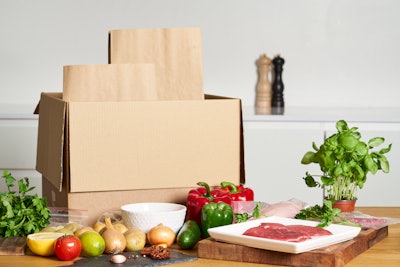
Over 70% of U.S. consumers have resigned themselves to cooking at home more frequently than they did before the pandemic, according to Coresight Research. While this fact seems to imply an immediate win for grocers, the reality is actually more complicated; many new competitors are entering the field to tap into this growth. For instance, Coresight Research also found that the popularity of subscription food services grew by nearly 70% in 2021.
Shoppers are drawn to subscription food services because of the availability of easy-to-make healthy options, the simplicity of ordering and the personalization of the ongoing relationship. These services can offer these benefits thanks to the surplus of customer data acquired during the sign-up process. Subscription food companies have access to shopper’s preferences, dietary needs, price points and more, making it easier than ever to offer a personalized experience. Many grocers, on the other hand, do not have this data readily available and they must take an extra step to be that personal.
So, how can traditional grocers compete with these benefits and win over the growing population of at-home cooks after the pandemic? By truly understanding the customer.
Introducing the customer intelligence platform
Customer intelligence platforms, or CIPs, offer grocers unique personalization strategies that can rival the subscription model.
So how do they work? Once grocers incentivize customers to develop a profile - as part of online shopping or a retailer’s loyalty program - CIPs take action. The software serves as the central hub of customer intelligence, leveraging all data from across the organization to help grocers better understand their customers. By providing automated insights for individual customers, CIPs can help marketers simultaneously increase personalization while scaling overall growth.
Unlike traditional customer data platforms that are common in the industry, CIPs help retailers stand out by incorporating customer insights into every aspect of the business to increase both sales and operational efficiencies.
There are a variety of ways grocers can leverage the data from a CIP to compete with digital-first subscription food services. Let’s dive into them.
1. Data-driven cart recommendations
With individualized customer data, a CIP can provide artificial intelligence (AI)-based recommendations based on past purchases, popular recipes or trends from other similar shoppers. This personalized experience driven by the data collected in the CIP can increase basket size by reminding customers that they might need peanut butter to go with their jelly, or by telling them which healthy alternative might enhance the dinner. The strategic use of this data can offset the idea that meal subscriptions are easier to use by showing the shopper exactly what they should get.
2. Curated coupons
Similarly, with personalization driven by the CIP, grocers can offer savings on products relevant to each individual customer. These recommendations are strategically driven with the goal of growing the customer’s lifetime value to the retailer.
By offering well-timed coupons, grocers can increase customer loyalty by showing that shopping in-store can cost the same, or even less, than the subscription option. This can also increase basket size, as customers are able to get more of the items they want within their budget.
3. In-store efficiency improvements
Meal-subscription fans may argue that nothing can compare to the ease of ordering provided by subscription food services. But, there are ways that traditional grocers can compete.
For example, stores can deploy a mobile app that can help shoppers locate items in the store quickly, so they can be in and out in mere minutes. Customers can draft a shopping list and immediately know which aisles to go in to optimize the length of the trip. A CIP can then analyze these customer journeys and determine any inefficiencies in the in-store experience and solve them before customer loyalty is impacted.
4. Personalized wellness tips
Healthy eating goes beyond just deciding what to buy. From meal inspiration to the dining table, making healthy choices should be as effortless a journey as possible. Meal subscription companies understand this and give customers immediate access to dietary information about each meal. To compete, traditional grocers must go beyond promoting nutritional labels or creating a generic “healthy foods” aisle.
Consumers today shop with a variety of dietary restrictions in mind – what’s healthy for one family member might not be healthy for another. Thirty-two million Americans have food allergies, 60% of Americans suffer from chronic illnesses that impact their diet and at least 36% of Americans follow specialty diets like Keto, Paleo or Vegan.
The grocery industry has a unique opportunity to insert itself at the very heart of the wellness revolution by combining data science and nutritional science. Personalized wellness solutions can provide individualized product suggestions based on factors such as health needs and dietary preferences. These platforms can score products and recipes based on health recommendations from doctors and create a healthy meal plan for each shopper.
The targeted recommendations from a personalized wellness solution also make for more cost-effective ad spend and greater ROI. The data collected gives retailers greater insight into what customers are buying and allows them to make more informed inventory and advertising decisions with brands.
Supermarkets that can insert themselves into the lifecycle of the “meal” will create a new future. This future goes beyond just guidance on products, it gives shoppers the ability to start with meal ideas and execute them by simplifying the shopping experience. This ensures that the journey from “meal inspiration” to the “dining table” is as effortless as possible.
Staying ahead of current and future competitors
While the pandemic changed buying behaviors in ways no one could have anticipated, there are always shifts in customer preferences just around the corner. The only way to stay ahead of the ever-changing food service and grocery trends is to anticipate and act on customer needs before the competition can. With enhanced access to customer preferences and innovative technology, grocers can adapt quickly so the store always grows with the shopper.




















